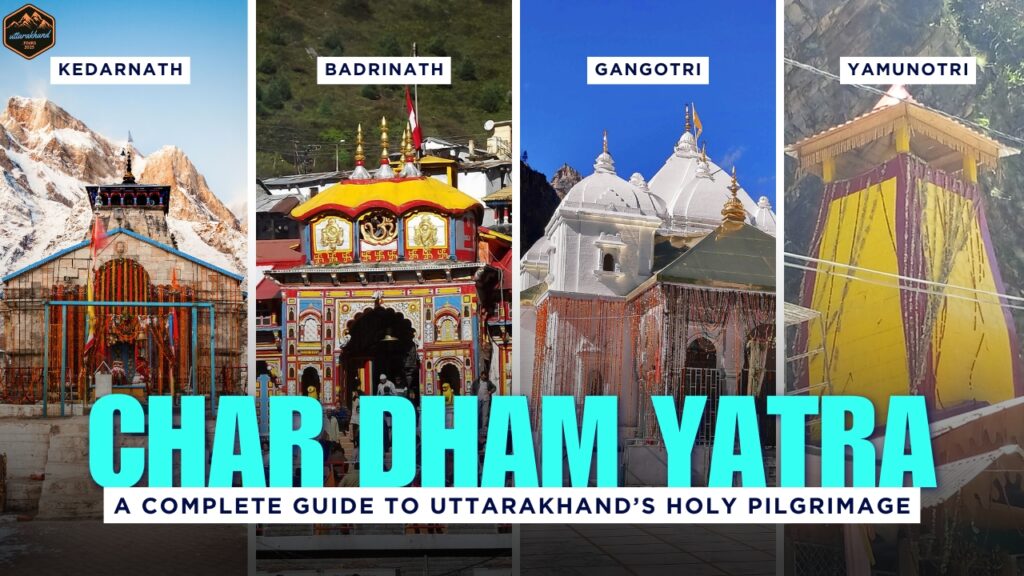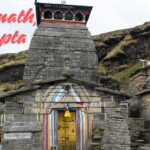Table of Contents
Char Dham Yatra
In the Hindu religion, the Char Dham Yatra is considered the most sacred pilgrimage, encompassing four holy sites: Badrinath, Yamunotri, Kedarnath, and Gangotri. This sacred journey in the Garhwal region of Uttarakhand is believed to wash away all sins, offering pilgrims a chance to release from the birth-death cycle and emerge with the purest heart and soul. Completing this sacred journey provides a heavenly feeling of completeness.
The hilly Garhwal ranges are thought to be the most sacred Himalayan ranges in India, where heaven and earth unite, and people consider themselves fortunate to be born or die here. The proper way to complete this Char Dham Yatra is to visit from left to right, starting at Yamunotri, moving to Gangotri, then Kedarnath, and finally terminating at Badrinath, completing the parikrama as per Hindu tradition.
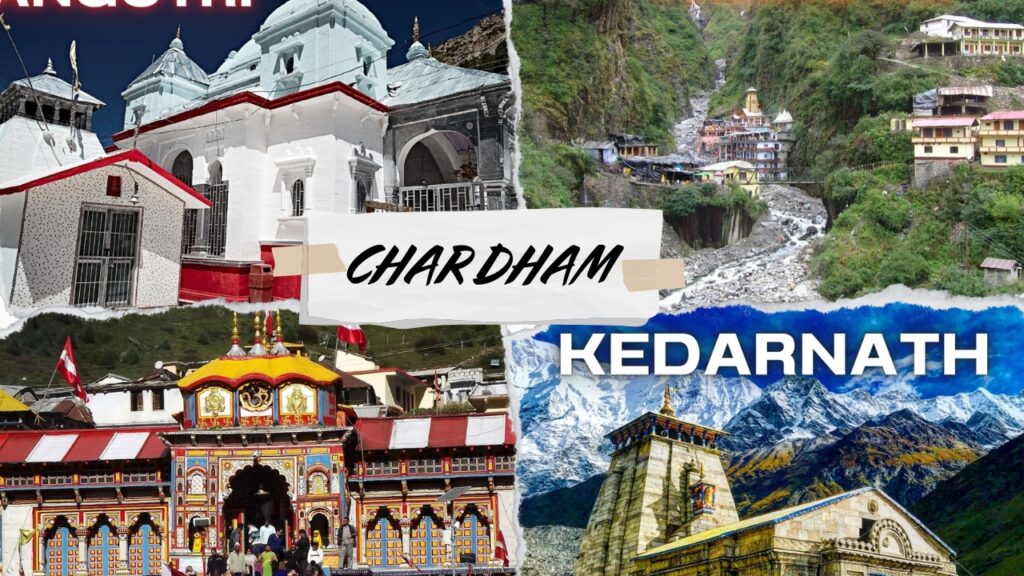
The Char Dham Yatra of Uttarakhand, also known as the Chota Char Dham, is a highly sacred circuit in Hinduism, visited by millions of devotees seeking a lifetime experience of witnessing the beauty of the Garhwal Himalayas. Conducted in the tradition of the arghya from west to east, this divine sojourn, founded by the 8th-century philosopher Adi Shankaracharya, is believed to wash away sins, bestow divine blessings, and effect salvation (Moksha).
This in-depth guide, crafted for travelers visiting uttarakhand.tours, covers each Dham, nearby places, activities, and essential travel tips for planning your Char Dham Yatra 2025. Whether you are a spiritual seeker or a thrill-seeker, this journey through Devbhoomi (Land of Gods), Uttarakhand, will remain etched in your memory.
What is the Char Dham Yatra?
The Char Dham Yatra of Uttarakhand is a pilgrimage to four abodes of God in the Garhwal region: Yamunotri, Gangotri, Kedarnath, and Badrinath. This smaller circuit serves as a good option for elderly pilgrims who cannot endure the larger circuit (Badrinath, Dwarka, Puri, and Rameshwaram), as it is confined within Uttarakhand’s boundaries. Dedicated to a deity or sacred river, worshippers find an opportunity to connect with the divine amidst snow-clad Himalayan mountains.
The yatra is open from April to November, with favorable periods in the summer months of May to June and the autumn of September to October. Temples close in winter due to heavy snowfall, with tentative opening dates for 2025 being April 30 for Yamunotri and Gangotri, May 2 for Kedarnath, and May 4 for Badrinath (verify on Uttarakhand Tourism).
This blog post is your ultimate destination for the Char Dham Yatra 2025, orbiting you around the history and significance of each Dham, with lovely options in proximity and activities, especially suiting travelers who wish to combine adventure, temple visits, and cultural stories.
Yamunotri: Origin of the Sacred Yamuna
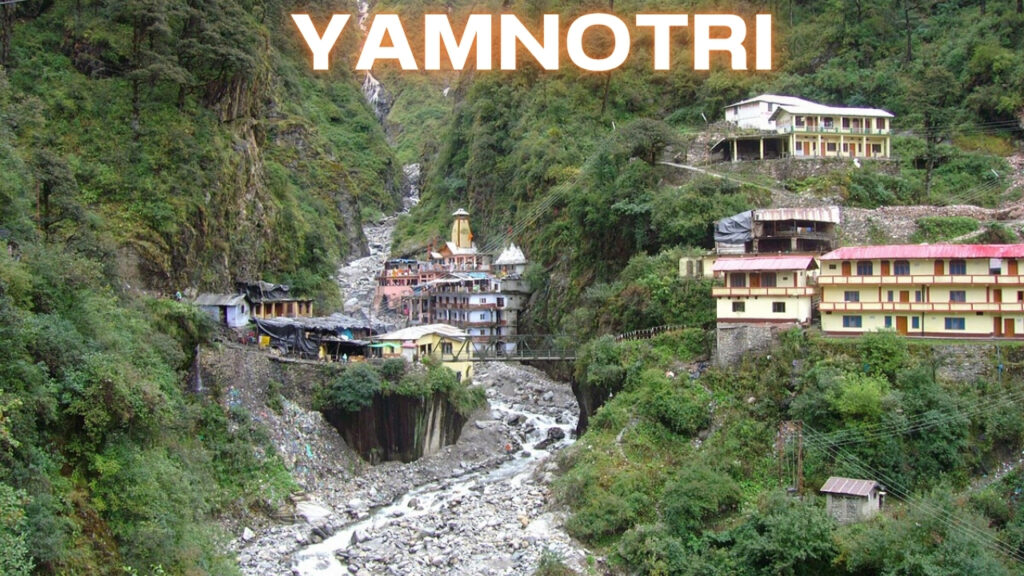
Overview and Significance
Yamunotri, the first site of the Char Dham Yatra, is devoted to Goddess Yamuna, associated with the Sun God, daughter of Surya, and sister of Yama, the Lord of Death. Situated at an elevation of 3,293 meters in Uttarkashi district, it is the source of the Yamuna River, India’s second-most sacred river.
The temple, built by Maharaja Pratap Shah of Tehri Garhwal and restored by Maharani Guleria of Jaipur in the 19th century, is a black marble construction with natural hot sulphur springs such as Surya Kund. Legend states that a dip in the Yamuna sets one free from all sins, and those who drown in the river are blessed with death free of untimely claims. The tranquil ambiance, flanked by the Bandar Poonch Parvat, adds to its spiritual and scenic pleasure.
How to Reach Yamunotri
- By Road: Take off to Barkot from Haridwar or Rishikesh (215 km, 5–6 hours drive). Reach Janki Chatti, the base for a 6-km trek to Yamunotri, via Barkot (45 km). This hike lasts around 4–5 hours and offers incredible views of the great Himalayan range.
- By Helicopter: Helicopter services from Dehradun’s Sahastradhara Helipad to Kharsali Helipad cut down travel time, followed by a 5.3-km trek or pony ride to the temple.
- Nearest Airport: Jolly Grant Airport, Dehradun (185 km from Barkot).
- Nearest Railway Station: Haridwar or Rishikesh (book via IRCTC).
Things to Do at Yamunotri
- Darshan at Yamunotri Temple: Make offerings and take part in the rituals of Goddess Yamuna. The temple is open from 6:15 AM to 2:00 PM and 3:00 PM to 9:30 PM.
- Dip in Surya Kund: This hot spring, located close to the temple, is considered medicinal. Pilgrims prepare rice and potatoes in the kund as prasad, which is then offered to the deity.
- Trek to Champasar Glacier: For adventurous travelers, keep trekking past the temple to reach the actual source of the Yamuna River at 4,421 meters (permits and a guide are required).
- Photography: Shoot the tranquil beauty of the Bandar Poonch Parvat and adjoining valleys.
Nearby Places to Visit
Hanuman Chatti
It is one of the beginning points of the trek that leads to two important places—Yamunotri and Dodi Tal. Yamunotri is only 13 km away from Hanuman Chatti, which can be easily covered by foot or on ponies. One can also find jeeps to Janki Chatti, which is only 6 km away from Hanuman Chatti. Hanuman Chatti is the meeting point of Yamuna and Ganga River. One can also find food items and raincoats from Hanuman Chatti.
Barkot
Situated at an elevation of 1,220 meters above sea level in the district of Uttarkashi, Barkot is one of the most important destinations to choose for excursion in the state of Uttarakhand. The place provides comfortable accommodation facilities and ensures easy stay after hectic travelling schedules. Besides the recreational value that this place has to offer, Barkot also has an ancient temple that is situated 49 km distance from Yamunotri.
Dodi Tal
As per Indian Mythology, Dodi Tal is the birthplace for Lord Ganesh and has a beautiful Ganesha Temple crafted along the banks of this lake. Dodi Tal is a freshwater lake that is situated at an elevation of 3,307 meters above sea level and is besieged with dense forest of rhododendrons, oak, and deodar. This lake is also called a mysterious lake as its depth cannot be measured till day. Dodi is home to endangered Himalayan Golden Trouts and many other rare species of fishes. Dodi Tal offers wonderful splendid sites and is a famous trekking spot.
Uttarkashi
Positioned at a raised level of 1,352 meters above sea level, Uttarkashi is a famous tourist spot. It is 78 km away from Hanuman Chatti and offers a picturesque view to travelers. The place is well connected by motorable roads and is a famous destination of the Uttarakhand state. Along the banks of River Bhagirathi, Uttarkashi offers a wonderful glimpse to serene environ and gushing water. Moreover, trekking interest in people here and around the world has led to construction of the reputed institute of Mountaineering—Nehru Institute of Mountaineering that offers training courses in trekking, climbing, and mountaineering.
Janki Chatti
On the way to trek to Yamunotri, Janki Chatti is the midpoint that can be easily reached by jeeps. It is situated at a mere distance of 7 km afore Yamunotri and is a renowned place for thermal springs. Many visitors stop by Janki Chatti to enjoy the sightseeing here and wash their sins in thermal springs.
Surya Kund
Amid several natural thermal springs in Yamunotri, Surya Kund is the most famous one. It is astonishing, but the water temperature of Surya Kund remains 190°F. Many pilgrims tie potatoes and rice to cook it by immersing it under the water of Surya Kund. After this, it is served as prasad. So, religious value attached to the place is high, but besides, there are many wonderful sights to lush green nature and extensive ranges that follow you all the way to Yamunotri.
Divya Shila
Divya Shila is a rock pillar that is situated outside the Yamunotri temple and is worshipped by Hindu pilgrims.
Tips for Yamunotri
- Bring warm clothes, good trekking shoes, and a walking stick for the hike.
- Get used to the high altitude to prevent altitude sickness.
- Book a place to stay in advance in Barkot or Janki Chatti, especially in peak season.
Gangotri: Where the Holy Ganges Emerges
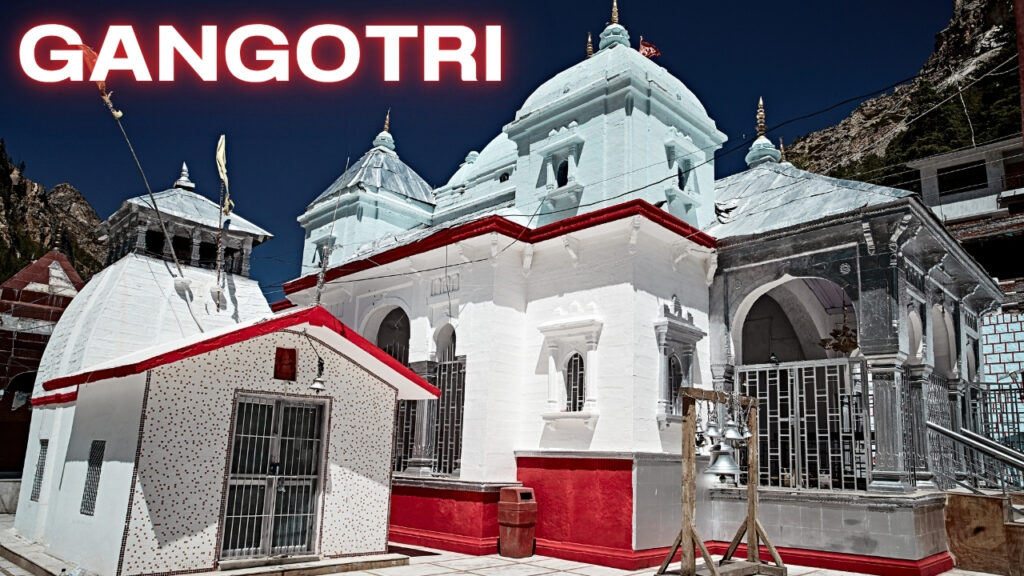
Overview and Significance
The second Dham, Gangotri, is dedicated to Goddess Ganga, the holiest river in Hinduism. Located at an elevation of 3,100 meters in Uttarkashi district, the temple is built on the brink of the Bhagirathi River, one of the source streams of the Ganges.
Constructed in the 19th century by Gurkha General Amar Singh Thapa, it is located in a forest of pine and deodar. According to Hindu mythology, Goddess Ganga took the form of a river to absolve the sins of King Bhagiratha’s predecessors following his severe penance of several centuries. Lord Shiva released the river Ganga from his locks at Gangotri, making it a very sacred place. Pilgrims bathe in the holy river to cleanse their souls.
How to Reach Gangotri
- By Road: The motor road bridge is 125 km from Barkot via Uttarkashi (100 km) and 25 km after Gangotri on the way to Uttarkashi is a road that branches off to the left for Dharali, 2 km, and then to Harshil, 75 km (taxis available). The whole distance from Haridwar is approximately 250 km and takes 7–8 hours.
- By Helicopter: Char Dham Yatra by helicopter from Kharsali Helipad to Harshil Civil Helipad and a 23-km road journey to Gangotri.
- Nearest Airport: Jolly Grant Airport, Dehradun (250 km).
- Nearest Railway Station: Haridwar or Rishikesh.
Things to Do at Gangotri
- Darshan at Gangotri Temple: Pray, visit the temple, and attend the evening aarti with a mesmerizing ritual by diyas and chants.
- Holy Dip in Bhagirathi River: A holy dip in the icy waters of the Bhagirathi is a must for the spiritual cleansing of both mind and body of the trekker (be careful of the current).
- Trek to Gomukh: The place where the Ganges originates, at a distance of 18 km from Gangotri, is a well-known trek for trekkers. The path takes you through Chirbasa and Bhojbasa with stunning views (permits are needed).
- Meditation and Yoga: The calm, soothing atmosphere is perfect for meditation and yoga.
Nearby Places to Visit
Uttarkashi
Positioned at an elevation of 1,352 meters above sea level, Uttarkashi is a place 93 km away from Gangotri and is a charming must-to-explore destination. Uttarkashi is strongly connected via roads and provides a smooth and swift traveling experience to all important destinations of Uttarakhand. On the banks of the holy river Bhagirathi, Uttarkashi doles out a splendid view. Furthermore, the National Institute for Mountaineering is also situated here, which offers various training courses in mountaineering and climbing.
Dodital
This freshwater lake is one of the finest sites around Gangotri. The lake flows at a height of 3,037 meters above sea level and is surrounded by dense forest of deodar, oak, and rhododendrons. It is said that Lord Ganesha was born on the banks of this lake. The depth of this lake is still a mystery. In addition, the beginning point of the 18-km-long trek of Dodital trek is Agoda. The entire trekking remains a fun-filled experience with beautiful sites to explore en route.
Kedartal
The way to Kedartal involves difficult trekking of 14 km that commences from Gangotri. The best about Kedartal is its clean and clear waters that mirror the reflection of snow-laden Himalayan peaks. En route to Kedartal trekking, the maximum height one may encounter is astounding, i.e., 4,219 meters. The lake flows at a height of 4,225 meters above sea level with magnificent Thalay Sagar running alongside, doling out an impeccable experience.
Gangnani
On the way to Gangotri, 47 km before, is a place known as Gangnani. It is known for its thermal spring. People bathe in the thermal spring to wash away their sins afore heading for Gangotri.
Harsil
Having plentiful scope for natural beauty, Harsil is an emerald of Uttarakhand. It is a perfect destination for adventure lovers. Harsil is located on the banks of river Bhagirathi and is 2,620 meters above sea level. The total distance from Gangotri to Harsil is 21 km. One can plan for an easy and short trek from Harsil to Shattal.
Tapovan
From Gaumukh Glacier, one can go ahead to explore Tapovan and Nandvan. It is suggested to hire a trekker here as it might get difficult for seasonal trekkers to cross the path sometimes. The trekking path from here is rock-strewn and can be a tedious affair at times. From Tapovan, tourists get a chance to sightsee amazing vistas and Garhwal Himalayas.
Bhairon Ghati
In the vicinity of the confluence of Jat Ganga and Bhagirathi River lies the beautiful Bhairon Ghati. The Ghati is located 10 km away from Gangotri. The place is famous for Lord Bhairav Nath temple that is situated here. The area around is surrounded by thick and dense forest. Bhairav Nath temple can be reached by traveling from Lanka to Bhairon Ghati via road and further by crossing the Jhanvi River.
Submerged Shivling
In the lap of Goddess Ganga sits the naturally made idol of Lord Shiva. The Shivling remains submerged during all the months and is visible only during winters when the water level decreases. As per old sayings, it is believed that Goddess Ganga and Lord Shiva have ascended in his matted locks here.
Tips for Gangotri
- Bring rainwear, as the area is known for surprise rain showers.
- Observe local customs, dress respectfully, and avoid littering.
- If you are up for treks to Gomukh or any other secluded area, engage a local guide.
Kedarnath: The Seat of Lord Shiva
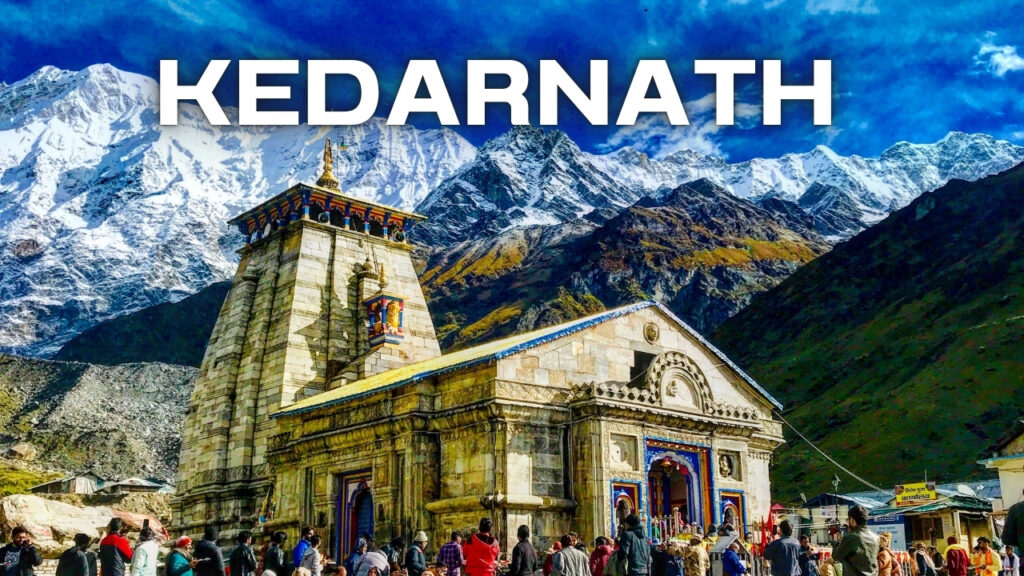
Overview and Significance
Kedarnath, resting at an altitude of 3,583 meters in the Rudraprayag district, is among the holiest Hindu temples, dedicated to Lord Shiva as one of the 12 Jyotirlingas. Constructed by the Pandavas and renovated by Adi Shankaracharya in the 8th century, it is a beautiful architectural masterpiece made of grey stone, offering permanent strength to survive the tough Himalayan climate.
Legend states that the temple was built by the Pandavas to atone for their sins committed during the Mahabharata war. A bull, manifested as Lord Shiva as Kedareshwar, decided to submerge in the ground, leaving his hump on the surface, forming a divine site.
How to Reach Kedarnath
- By Road: Drive from Gangotri to Guptkashi (150 km, 5–6 hours), then to Gaurikund (72 km), the starting point for the 16-km trek to Kedarnath. The hike is strenuous but offers spectacular views.
- By Helicopter: Fly from Phata Helipad to Kedarnath Helipad. The helipad is a brief stroll from the temple.
- Nearest Airport: Jolly Grant Airport, Dehradun (230 km from Gaurikund).
- Nearest Railway Station: Haridwar or Rishikesh.
Things to Do at Kedarnath
- Visit Kedarnath Temple: Seek blessings from Lord Shiva and watch the evening aarti, which is truly a religious experience.
- Trekking: A stunning 16-km-long route from Gaurikund to Kedarnath trek that passes through rocky terrains and waterfalls.
- Bhairavnath Temple: Situated close to Kedarnath, this small temple, traversed in dense forests, is a sanctuary for the fearsome Lord Bhairava.
- Photography: Take photos of the snow-covered Kedarnath range and the peaceful flow of the Mandakini River.
Nearby Places to Visit
Kedarnath Temple
The name of Kedarnath temple comes amongst the holiest pilgrimage centers of India. This temple is dedicated to Lord Shiva and comes amongst the Char Dhams of India. The temple is situated at an elevation of 3,584 meters above sea level in the surroundings of the great Himalayas. According to mythology, Pandavas wanted to come out from the entire sin they did during the Mahabharata war at this place. But Lord Shiva was extremely angry with them and had converted himself into the form of a bull and dug himself under the ground. Thus, this place contains more religious importance and is known as a Char Dham of India.
Vasuki Tal
Vasuki Tal is located only 7 km away from Kedarnath, and you can reach this place by a simple trek. You’ll find this lake at an elevation of 4,150 meters above sea level along with the boundary of the great Himalayan peaks.
Gaurikund
Gaurikund is located at an elevation of more than 6,000 feet above sea level and is the base camp for the trek to Kedarnath. The place Gaurikund is dedicated to Goddess Parvati (wife of Lord Shiva), and the story of this place is also associated with Lord Ganesha. This place is situated amidst lush green forest, providing serene environments and memorable views.
Shankaracharya Samadhi
Everyone knows Shankaracharya, who established the Char Dhams of India, those that are still the holiest pilgrimage centers. He went to his Samadhi at an early age of 32, and thus this place contains massive religious significance.
Kalimath
Kalimath is basically an ancient temple and one amongst the ‘Seedha Peeth,’ holding matchless religious importance, and due to this, a massive crowd of devotees can be found at this place throughout the year. Kalimath is also called Kaviltha, and it’s basically a divine village. You’ll find this place at an elevation of almost 6,000 feet above sea level and belongs to the Rudraprayag district of Uttarakhand. This temple was established by Adi Shankaracharya.
Ukhimath
Ukhimath is a well-known tourist destination of India and is situated at an elevation of 1,311 meters above sea level. During winters, the place has more religious significance as this is assumed to be the home of Lord Shiva and Madhyamaheswar. Due to this, you can experience an amazing crowd at this place during winter.
Chopta
Due to exceptional natural beauty and sightseeing, Chopta is acknowledged as the mini Switzerland of Uttarakhand. In recent years, Chopta has become the leading vacation spot, and the number of visitors is increasing at an outstanding rate. Tungnath is known as the highest temple of Uttarakhand, situated and located only at a distance of 3.5 km from Chopta.
Rudraprayag
Rudraprayag is the major city of Uttarakhand and known for its beauty and religious significance. It is located at the convergence point of the river Alaknanda and Mandakini. Rudraprayag is situated at a very short distance from Kedarnath, i.e., 80 km only. The place is named based on the name of Lord Shiva, as Rudra is the 108th name of Lord Shiva.
Trijuginarayan Temple
The place is the evidence of the marriage of Lord Shiva and Goddess Parvati. You’ll find an immortal flame that is still burning around the place where the marriage of Lord Shiva was held with Goddess Parvati.
Tips for Kedarnath
- Get into shape for the hike; it’s tough at high altitude, so train yourself beforehand.
- Bring first aid supplies, medication, and oxygen bottles for altitude sickness.
- Helicopter tickets must be booked well in advance since they are always in demand, especially during peak season (check HeliYatra).
Badrinath: Abode of Lord Vishnu
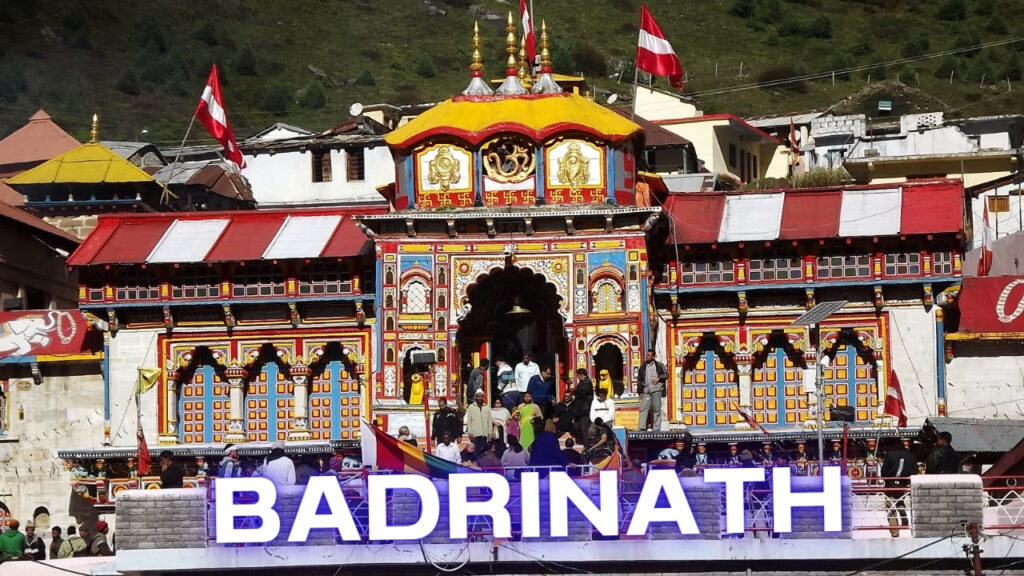
Overview and Significance
Badrinath, at the height of 3,133 meters in the Chamoli district, is dedicated to Lord Vishnu as Badri Narayan. Situated amidst the Nar and Narayan mountain ranges, the temple is one of the Panch Badri (Dhyan Badri, Yog Badri, Vriddh Badri, and Badri Vishal) and one of the Sapta Badri (Vriddh Badri, Adi Badri, and Joshimath). It is one of the holiest shrines of the Vaishnavites, and the divine idol of Badrinath Dham is considered the holiest of the holy.
The present temple is believed to have been built by Adi Shankaracharya, an Indian philosopher credited with unifying and establishing the main currents of thought in Hinduism. According to legend, the idol of Lord Vishnu was first discovered by Shankaracharya in the Alaknanda River and later worshipped in the Tapt Kund. Badrinath is one of the most important temples of the Chota Char Dham, which comprises Badrinath, Kedarnath, Yamunotri, and Gangotri, as declared by Adi Shankaracharya.
How to Reach Badrinath
- By Road: Drive from Kedarnath to Badrinath via Joshimath (224 km, 7–8 hours). Direct buses and taxis are available from Haridwar or Rishikesh.
- By Helicopter: The nearest helicopter facility is Phata Helipad to Badrinath Helipad, after which one can cover a 1-km distance by foot to reach the temple.
- Nearest Airport: Jolly Grant Airport, Dehradun (310 km).
- Nearest Railway Station: Haridwar or Rishikesh.
Things to Do at Badrinath
- Badrinath Temple Darshan: Witness either the morning or the evening aarti and seek the blessings of Lord Vishnu.
- Tapt Kund: A hot water spring where you can bathe before entering the temple; the spring is said to hold medicinal value.
- Visit Mana Village: Situated 3 km away from Badrinath, it is believed to be the last inhabited village in India before the Indo-Tibetan border. Pay a visit to Vyas Gufa and Ganesh Gufa for their mythological importance.
- Trek to Neelkanth: The trek to Neelkanth peak is a difficult trek that gives you a majestic view of Badrinath valley and Neelkanth Peak.
Nearby Places to Visit
Badrinath Temple
Badrinath Temple is one of the most sacred temples in Badrinath District. Situated on the banks of Alaknanda River, surrounded by Nar Parvat, Badrinath Temple is dedicated to Lord Vishnu. The temple was established by saint philosopher Adi Shankaracharya in the 8th century and holds a small cupola of gilt bull and spire and is built in the shape of a cone.
The Badrinath temple is well known for its Badrinath deity sculpted in black stone, which is around one meter large and represents Lord Vishnu seated in a contemplative pose. The main entrance gate of Badrinath temple is called “Singh Dwara,” which is a major center of attraction of the temple.
Besides this, the temple has stunning 15 idols of different Hindu gods. Millions of domestic as well as foreign travelers and devotees visit this holy place every year from May to October. During the winter, the temple remains closed because of heavy snowfall.
Tapt Kund
Tapt Kund is a natural thermal spring and considered the dwelling of Lord Agni, where one has to take a sacred dip. The dip into Tapt Kund is very important before going to the temple and is also believed to spiritually revitalize and cleanse all sins. All the followers and tourists take a holy dip in Tapt Kund together without even knowing each other. The expected temperature of the water of Tapt Kund is 45°C. This holy place is a worth-watching destination.
Brahma Kapal
Brahma Kapal is a place located on the banks of River Alaknanda and is placed in the region of Badrinath Temple. It is believed that at this place Lord Brahma resides, and it is also believed that the head of Lord Brahma had fallen off in Brahma Kapal Ghat. Hindu devotees perform various rituals and prayers to the dead ancestors and also offer shraddha to their intimates.
Neelkanth
Neelkanth, which is also tagged as “Garhwal Queen,” is named after God Shiva, who is also called Neelkanth. It is a snowy peak located above Badrinath temple in the shape of a pyramid. Neelkanth peak is located at an altitude of 6,597 meters above sea level. It is a beautiful site where the sun spreads its first ray. Numerous travelers can also come across various Brahmakamals, which can be viewed at the foot of the Neelkanth Peak. Furthermore, tourists can also cover 6 kilometers of trekking route easily on this peak.
Mata Murti Temple
Located at a distance of 3 kilometers from Badrinath, Mata Murti Temple is a famous holy temple dedicated to the mother of Lord Narayan. According to a myth, Mata Murti worshipped God Vishnu to take his next birth as her son, and after blissfully agreeing with that, Lord Vishnu came into the world as twins, Narayana and Nara, to kill a giant. There is an admired faith that the goddess has the power of conceding Vairagya to those who meditate honestly in her presence. Every year, a fair is organized in the land of Mata Murti Temple, where the mother of Shri Badrinath is worshipped.
Charanpaduka
Located at a distance of 3 kilometers from Badrinath Temple, Charanpaduka is a famous rock as it possesses the footprints of Lord Vishnu. This temple falls on a lovely meadow covered with diverse wildflowers in the summers. There is a belief that an honest visit to this sacred place will retrieve you from ailments and other troubles. There are numerous caves and rocks on the way that direct to Charanpaduka. This path will also lead you to the bottom of Neelkanth peak, where you can see numerous Brahmakamals.
Narad Kund
Situated nearby Tapt Kund, Narad Kund is one of the sacred places in Badrinath after the name of Badrinath Temple. It is the place where the deity of Lord Vishnu was recovered by Adi Guru Shankara. It is assumed that the name of Narad Kund was given after Saint Narada Muni, who wrote Narada Bhakti Sutra at this spot. Narad Kund is visited to take a sacred dip into the holy water before visiting the temples. Besides this, there are many other natural hot water springs situated.
Satopanth
Situated at a distance of 25 km from Badrinath and set up above 4,402 meters above sea level, Satopanth is a triangular-shaped lake with three corners extending inside the circumference of about a kilometer. It is enclosed by heavy snow-covered peaks and is named after the Hindu Lords Vishnu, Mahesh, and Brahma. There is a belief that these three gods inhabit one corner each of the Satopanth Lake.
Mana
Located at a distance of 3 kilometers from Badrinath, Mana is very near to the Tibet border and is one of the last villages of our country. It is occupied by Indo-Mongolian tribes, often referred to as Bhotias. Most of the travelers who visit Badrinath also come to glimpse the end of the road at Mana.
Bheem Pul
Located opposite to the Vyas Gufa in Mana Village, Bheem Pul is an exciting and adventurous tourist place. It is believed that this is the place where Bheem (one of the five Pandava brothers) threw a huge rock to make a path joining the two mountains so that Draupadi could easily walk over it. Below this mountain, the Saraswati River flows with force and joins the Alaknanda River.
Sheshnetre
Located at a distance of 1.5 km from Badrinath, Sheshnetra is one of the famous holy sites. This is a big massif stone that is distinct with an eye of a renowned snake. It is said that Lord Vishnu took leave on an enormous snake called Ananta Shesha. This holy place has natural marks on the rock. There is a popular belief that Sheshnetra protects the sanctified temple of Lord Badrinath.
Vyas Cave
Vyas Gufa or Vyas Cave is a popular place from where Ved Vyas stated the entire Mahabharata to Lord Ganesha so that he could write. Ved Vyas also contemplated in this cave.
Ganesha Cave
Ganesha Cave is the sacred natural cave where God Ganesha wrote the Mahabharata as stated by Ved Vyas from Vyas Gufa.
Panch Dharas and Panch Shilas
The Panch Dharas (five rivers), which are very popular in Badaripuri, are Kurma, Prahlad, Bhrigu, Indira Dhara, and Urvashi. The most remarkable stream of these is the Indira Dhara, situated about 1.5 kilometers north of the town Badaripuri. Around the Tapt Kund, there are five blocks of rocks of legendary importance named Narsimh, Narad, Garur, Barah, and Markandeya Shilas (stone).
Vasudhara Falls
Located at a distance of 4 kilometers from Badrinath, Vasudhara Falls is one of the most popular tourist attractions, which falls in the Mana Village. It is surrounded by stunning mountain peaks and is set up at an elevation of 12,000 ft above sea level. The water of the Vasudhara appears to be like milk falling down the mountain.
Pandukeshwar
Located at a distance of 4 kilometers from Govind Ghat and 24 kilometers from Badrinath, Pandukeshwar is a quite holy place. There are two popular temples—one for Lord Vasudev and the other for Yoga Badari Narayan. It is believed that this place was built by King Pandu, father of the Pandavas. Both the temples are ancient and show major importance for Hindu followers.
Joshimath
Located at a distance of 46 kilometers from Badrinath and set at an altitude of 1,890 meters above sea level, Joshimath is one of the four ‘maths’ formed by Saint Philosopher Adi Guru Shankaracharya. It is considered the dwelling of Shri Badrinath during winters. This place is conveniently connected with Auli by the premier cable car of Asia. It is a worth-watching destination in Uttarakhand.
Auli
Located at a distance of 60 kilometers from Badrinath, Auli is the best tourist destination and adventurous spot for people who seek adventure, as it is the most popular skiing and paragliding location of Uttarakhand. Auli gives an amazing and mind-blowing view of the enchanting snow-covered Himalayan range and is located at an altitude of 3,050 meters above sea level. Auli is also well connected with motorable roads and is a must-watch destination while visiting Badrinath.
Valley of Flowers
Valley of Flowers National Park is located in the west Himalayas, wrapping an area of 87.50 sq km. Tourists can reach there by following an easy trek of 16 kilometers beginning from Govindghat towards the Valley of Flowers. The whole valley is enclosed with thriving flowers from the months of June to October and with heavy sheets of snow in winters. In the year 1982, the Valley of Flowers was confirmed as a national park and is now also a World Heritage Site.
Hemkund Sahib
Hemkund Sahib is a popular holy destination and is situated at an altitude of 4,329 meters above sea level, surrounded by various snow-covered peaks, which are combined called Hemkund Parvat. It is believed that Guru Gobind Singh Ji, the tenth Guru of the Sikhs, meditated at Hemkund Sahib for a long time. The name Hemkund means Lake of Snow, and the holy water of this is as cold as snow. A star-shaped Gurudwara close to the lake is visited by numerous devotees and travelers every month. This place also has a temple devoted to Lakshman, brother of God Ram. People can reach there by completing a trek of 19 km commencing from Govindghat.
Adi Badari
Located at a distance of 17 kilometers from Karnaprayag, Adi Badari is a famous temple dedicated to Lord Narayan and is renowned by a hoist platform in the pyramidal shape. It is well connected with road routes and easily approached by motorable road.
Tips for Badrinath
- Soak yourself in Tapt Kund before darshan, as it is believed to be a traditional ritual.
- Visit Mana Village early in the morning to avoid the rush of tourists.
- Bring warm clothes and rain gear, since the weather may be capricious.
Planning Your 2025 Char Dham Yatra
Best Time to Visit
The best time to visit the Char Dham Yatra is in the months of May to June and again in September to October, when the climate is moderate (10°C–25°C) and the roads are clear. Don’t travel during the monsoon season (July–August) due to the high risk of landslides. The temples are closed from November to April on account of heavy snow.
How to Register
Biometric registration is compulsory and can be completed online or at counters in Haridwar and Rishikesh. Fill the form, upload the necessary documents (ID proof), and get an e-Pass, which is checked at multiple points of the yatra.
Travel Options
- By Road: From Haridwar or Rishikesh, take the route: Haridwar → Barkot → Yamunotri → Uttarkashi → Gangotri → Guptkashi → Kedarnath → Joshimath → Badrinath. The trip takes 10–12 days by bus or private taxi.
- By Helicopter: Dehradun offers helicopter packages to all the Dhams in 4–5 days duration, which is fit for senior citizens or people with time constraints.
- Custom Packages: Tour operators such as Thomas Cook India and eUttaranchal provide budget, deluxe, and luxury packages beginning from main cities, including Delhi, Mumbai, and Bangalore.
Cost Estimates
- Budget: ₹15,000–₹25,000 per person (including public transport, simple stay arrangements).
- Mid-Range: ₹30,000–₹50,000 (private taxis, nice hotels).
- Luxury: ₹80,000–₹1,50,000 (helicopter services, star-rated hotels).
Essential Items to Carry
- Warm clothing (woollen sweaters, jackets, gloves, windcheaters).
- Robust trekking boots and a walking stick.
- First-aid kit, basic medicines, disposable oxygen cylinders.
- High-energy snacks (dry fruits, chocolates, ORS, glucose biscuits).
- Identity card, Yatra e-Pass, power bank, torch.
Safety and Precautions
- Acclimatize to high altitudes to avoid altitude sickness (headache, nausea, shortness of breath).
- Monitor local weather and carry rain gear.
- For treks, hire local guides; respect local customs by dressing modestly and not littering.
- Make reservations for lodging and travel, especially during high seasons (May–June, September–October).
Why Go for the Char Dham Yatra?
The Char Dham Yatra is not just a pilgrimage; it’s a spiritual awakening, cultural immersion, and a connection with nature. The tranquil surroundings at the foot of the Himalayas, blended with the flowing rivers Yamuna, Ganga, Bhagirathi, and Alaknanda, make the yatra an ideal location for yoga and meditation. Whether you pursue divine blessings, adventure, or the myriad beauty of Uttarakhand’s mountains, the yatra has something to interest everyone.
Nearby Attractions Beyond the Dhams
Haridwar
The entry point to the Char Dham pilgrimage and the site of the Ganga Aarti at Har Ki Pauri, a spiritual gathering.
Rishikesh
A center for yoga, outdoor adventure (river rafting, bungee jumping), and spiritual retreats on the Ganges.
Tehri Lake
Asia’s biggest human-made lake, offering opportunities for jet skiing, boating, and nature photography.
Panch Prayag
Five holy river confluences (Devprayag, Rudraprayag, Karnaprayag, Nandprayag, Vishnuprayag) with religious significance.
Unique Experiences
- Join the traditional rituals and aartis at every Dham to experience a heightened spiritual connection.
- For local interactions, take a walk in Mana Village or Harshil and enjoy the warmth and authentic food of Uttarakhand.
- Offbeat treks like Dayara Bugyal or Valley of Flowers are worth exploring for adventure and natural beauty.
Final Thoughts
The Char Dham Yatra 2025 is a soul-stirring journey through Uttarakhand’s sacred shrines, offering spiritual fulfillment, adventure, and the chance to witness the Himalayas’ pristine beauty. From the tranquil Yamunotri to the divine Badrinath, each Dham provides a unique blend of devotion and exploration. Nearby attractions like Haridwar, Rishikesh, and the Valley of Flowers add cultural and natural richness to the experience.
Plan your pilgrimage with care, choosing the right season, transport, and accommodations to suit your needs. Whether you trek through rugged terrains or opt for a luxurious helicopter tour, the Char Dham Yatra promises a transformative experience that resonates long after the journey ends. Book your tour with trusted operators, pack wisely, and embark on this sacred odyssey to connect with the divine and the breathtaking landscapes of Devbhoomi Uttarakhand.

